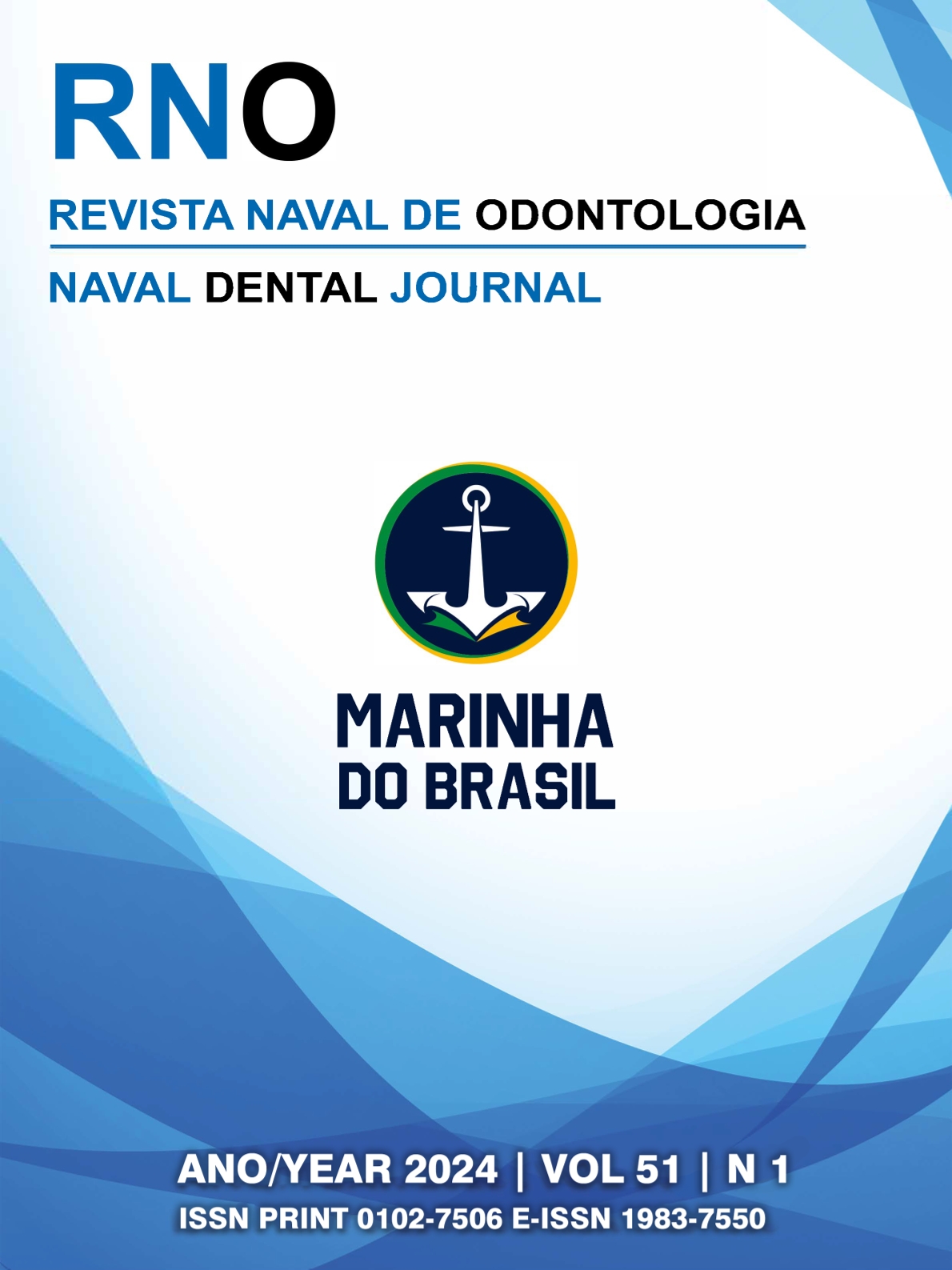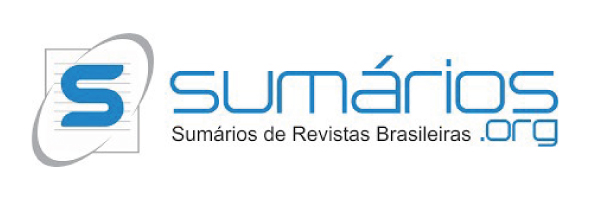FATORES QUE INFLUENCIAM INSUCESSOS NO USO DE MINI-IMPLANTES: UMA REVISÃO DE LITERATURA
DOI:
https://doi.org/10.69909/1983-7550-fatores-que-influenciam-insucessos-no-uso-de-mini-implantes-uma-revisao-de-literaturaPalavras-chave:
Ortodontia; Mini-implante; Miniparafuso; Micro-implanteResumo
Os dispositivos de ancoragem temporária ou mini-implantes adquirem cada vez mais relevância no manejo clínico dos tratamentos ortodônticos. Entretanto, apesar dos resultados clínicos expressivos obtidos, algumas intercorrências podem acometer a ancoragem no decorrer do tratamento. Os insucessos podem estar associados a fatores relacionados ao profissional, ao paciente ou ao próprio parafuso. Outrossim, existem fatores que podem contribuir para o sucesso clínico na utilização destes dispositivos, como a seleção apropriada do comprimento do mini-implante, a escolha de áreas adequadas para inserção do dispositivo, além de conhecimentos acerca da densidade óssea, de forma a contribuir para a estabilidade primária, a prática de bons hábitos de higiene bucal ou ainda a utilização de dispositivos autoperfurantes. Assim, o presente estudo propôs-se a revisar a literatura científica disponível acerca de mini-implantes com artigos científicos selecionados utilizando as bases de dados PubMed, Scopus, Web of Science, Cochrane Library, Embase, BVS, Opengrey, Google Scholar e Catálogo de teses e dissertações. Após aplicados os critérios de seleção, 32 artigos foram selecionados para compor este trabalho. Conclui-se que a utilização dos mini-implantes mantém o controle ideal da ancoragem, de modo a evitar movimentações dentárias indesejáveis, sendo inegável o sucesso clínico dos dispositivos de ancoragem temporária na Ortodontia. Entretanto, é comprovado que complicações cuja etiologia pode variar entre profissional, paciente ou o próprio parafuso são capazes de acometer a ancoragem no decorrer do tratamento ortodôntico, de modo a implicar falhas e insucesso dos miniparafusos.
Referências
2.Chin MY, Sandham A, de Vries J, Van der Mei HC, Busscher HJ. Biofilm formation on surface characterized micro-implants for skeletal anchorage in orthodontics. Biomaterials. 2007;28(11):2032-40.
3.Papadopoulos MA, Tarawneh F, The use of miniscrew implants for temporary skeletal anchorage in orthodontics: A comprehensive review. Oral Surg Oral Med Oral Pathol Oral Radiol Endod. 2007;103:e6-e15.
4.Papadopoulos MA, Papageorgiou SN, Zogakis IP. Clinical Effectiveness of Orthodontic Miniscrew Implants: a Meta-analysis. J Dent Res. 2011;90(8):969-75.
5.Pithon MM, Figueiredo DS, Oliveira DD. Mechanical evaluation of orthodontic mini-implants of different lengths. J Oral Maxillofac Surg. 2013;71(3):479-86.
6.Severo FC, Barbosa GF. Risk factors and success rates associated with orthodontic mini-implants: a literature review. Rev Odonto Cienc 2015;30(4):200-204.
7.Manni A, Cozzani M, Tamborrino F, De Rinaldis S, Menini A. Factors influencing the stability of miniscrews. A retrospective study on 300 miniscrews. Eur J Orthod. 2011;33(4):388-95.
8.Truong VM, Kim S, Kim J, Lee JW, Park YS. Revisiting the Complications of Orthodontic Miniscrew. Biomed Res Int. 2022;1;2022:8720412.
9.Kravitz ND, Kusnoto B. Risks and complications of orthodontic miniscrews. Am J Orthod Dentofacial Orthop 2007;131:S43-S51.
10.Wu TY, Kuang SH, Wu CH. Factors associated with the stability of mini-implants for orthodontic anchorage: a study of 414 samples in Taiwan. J Oral Maxillofac Surg. 2009;67(8):1595-9.
11.Suzukia EY, Suzukia B. Placement and removal torque values of orthodontic miniscrew implants. J Orthod Dentofacial Orthop 2011;139:669-78.
12.Chugh T, Jain AK, Jaiswal RK, Mehrotra P, Mehrotra R. Bone density and its importance in orthodontics. J Oral Biol Craniofac Res. 2013;3(2):92-7.
13.Kim JS, Choi SH, Cha SK, Kim JH, Lee HJ, Yeom SS, et al. Comparison of success rates of orthodontic mini-screws by the insertion method. Korean J Orthod. 2012;42(5):242-8.
14.Garfinkle JS, Cunningham LL Jr, Beeman CS, et al. Am J Orthod Dentofacial Orthop. Evaluation of orthodontic mini-implant anchorage in premolar extraction therapy in adolescents. 2008;133(5):642-53.
15.Romano, FL; Consolaro, A. Why are mini-implants lost: The value of the implantation technique! Orthodontic Insight • Dental Press J. Orthod. 2015;20(1).
16.Mohammed H, Wafaie K, Rizk MZ, Almuzian M, Sosly R, Bearn DR. Role of anatomical sites and correlated risk factors on the survival of orthodontic miniscrew implants: a systematic review and meta-analysis. Prog Orthod. 2018;24;19(1):36.
17.Giudice AL, Rustico L, Longo M, Oteri G, Papadopoulos MA, Nucera R. Complications reported with the use of orthodontic miniscrews: A systematic review. Korean J Orthod. 2021;25;51(3):199-216.
18.Apel S, Apel C, Morea C, Tortamano A, Dominguez G C, Conrads G. Microflora associated with successful and failed orthodontic miniimplants. Clin Oral Impl Res. 2009;20(11):1186-90.
19.Dalessandri D, Salgarello S, Dalessandri M, Lazzaroni E, Piancino M, Paganelli C, et al. Determinants for success rates of temporary anchorage devices in orthodontics: a meta-analysis (n > 50). Eur J Orthod. 2014;36(3):303-13.
20.Melo AC, Andrighetto AR, Hirt SD, Bongiolo AL, Silva SU, Silva MA. Risk factors associated with the failure of miniscrews - A ten-year cross sectional study. Braz Oral Res. 2016;24;30(1):e124.
21.Papageorgiou SN, Zogakis IP, Papadopoulos MA. Failure rates and associated risk factors of orthodontic miniscrew implants: a meta-analysis. Am J Orthod Dentofacial Orthop. 2012;142(5):577-595.e7.
22.Chen YJ, Chang HH, Huang CY, Hung HC, Lai EH, Yao CC. A retrospective analysis of the failure rate of three different orthodontic skeletal anchorage systems. Clin Oral Implants Res. 2007;18(6):768-75.
23.da Cunha AC, Marquezan M, Lima I, Lopes RT, Nojima LI, Sant'Anna EF. Influence of bone architecture on the primary stability of different mini-implant designs. Am J Orthod Dentofacial Orthop. 2015;147(1):45-51.
24.Marquezan M, Lima I, Lopes RT, Sant'Anna EF, de Souza MM. Is trabecular bone related to primary stability of miniscrews? Angle Orthod. 2014 May;84(3):500-7.
25.Holm L, Cunningham SJ, Petrie A, Cousley RR. An in vitro study of factors affecting the primary stability of orthodontic mini-implants. Angle Orthod. 2012;82(6):1022-8.
26.Manni A, Cozzani M, Tamborrino F, De Rinaldis S, Menini A. Factors influencing the stability of miniscrews. A retrospective study on 300 miniscrews. Eur J Orthod. 2011;33(4):388-95.
27.Baek SH, Kim BM, Kyung SH, Lim JK, Kim YH. Success rate and risk factors associated with mini-implants reinstalled in the maxilla. Angle Orthod. 2008;78(5):895-901.
28.Casaña-Ruiz MD, Bellot-Arcís C, Paredes-Gallardo V, García-Sanz V, Almerich-Silla JM, Montiel-Company JM. Risk factors for orthodontic mini-implants in skeletal anchorage biological stability: a systematic literature review and meta-analysis. Sci Rep. 2020;3;10(1):5848.
29.Chaddad K, Ferreira AF, Geurs N, Reddy MS. Influence of surface characteristics on survival rates of mini-implants. Angle Orthod. 2008;78(1):107-13.
30.Knutson KJ, Berzins DW. Corrosion of orthodontic temporary anchorage devices. Eur J Orthod. 2013;35(4):500-6.
31.Reynders R, Ronchi L, Bipat S. Mini-implants in orthodontics: a systematic review of the literature. Am J Orthod Dentofacial Orthop. 2009;135(5):564.e1-19.
32.Sherwood KH, Burch JG, Thompson WJ. Closing anterior open bites by intruding molars with titanium miniplate anchorage. Am J Orthod Dentofacial Orthop 2002;122(6):593-600.
33.Sugawara J, Baik UB, Umemori M, Takahashi I, Nagasaka H, Kawamura H, Mitani H. Treatment and posttreatment dentoalveolar changes following intrusion of mandibular molars with application of a skeletal anchorage system (SAS) for open bite correction. Int J Adult Orthodon Orthognath Surg. 2002;17(4):243-53.
34.Sugawara J. Temporary skeletal anchorage devices: the case for miniplates. Am J Orthod Dentofacial Orthop. 2014 May;145(5):559-65.
35.Malik F, Khan F, Ali S, Rana F, Haq H, Hussain M. Factors affecting success and failure of orthodontic mini-implants: A retrospective review. Professional Med J. 2023;30(02):285-291.
36.El Honsali Y, Ben Mohimd H, Zaoui F, Benyahia H. Contribution of digital technology to the surgical technique of miniscrew insertion: a literature review. Nav Dent J. 2023;50(2): 31-38.










